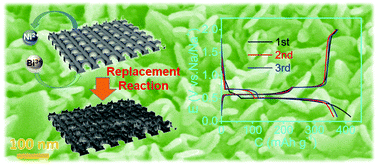In situ synthesis of Bi nanoflakes on Ni foam for sodium-ion batteries†
Abstract
We report a facile method to in situ synthesize Bi nanoflakes on Ni foam (Bi/Ni) via a replacement reaction, which can directly work as an anode for sodium-ion batteries (SIBs) without further treatment. The integrated nanoflake structure of the Bi/Ni effectively accommodates the dramatic volume changes of Bi during cycling, and favors both electron and Na+ transport through the electrode. This ensures high cycling performance and good rate capability. The sodiation/desodiation of Bi is revealed to be composed of two successive steps: Bi ↔ NaBi and NaBi ↔ Na3Bi. This facile strategy will encourage more investigations into the design and synthesis of integrated electrodes for high-performance SIBs.



 Please wait while we load your content...
Please wait while we load your content...